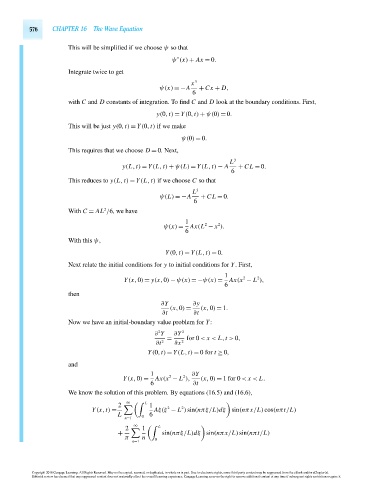Page 596 - Advanced_Engineering_Mathematics o'neil
P. 596
576 CHAPTER 16 The Wave Equation
This will be simplified if we choose ψ so that
ψ (x) + Ax = 0.
Integrate twice to get
x 3
ψ(x) =−A + Cx + D,
6
with C and D constants of integration. To find C and D look at the boundary conditions. First,
y(0,t) = Y(0,t) + ψ(0) = 0.
This will be just y(0,t) = Y(0,t) if we make
ψ(0) = 0.
This requires that we choose D = 0. Next,
L 3
y(L,t) = Y(L,t) + ψ(L) = Y(L,t) − A + CL = 0.
6
This reduces to y(L,t) = Y(L,t) if we choose C so that
L 3
ψ(L) =−A + CL = 0.
6
2
With C = AL /6, we have
1
2
2
ψ(x) = Ax(L − x ).
6
With this ψ,
Y(0,t) = Y(L,t) = 0.
Next relate the initial conditions for y to initial conditions for Y.First,
1
2
2
Y(x,0) = y(x,0) − ψ(x) =−ψ(x) = Ax(x − L ),
6
then
∂Y ∂y
(x,0) = (x,0) = 1.
∂t ∂t
Now we have an initial-boundary value problem for Y:
2
∂ Y ∂Y 2
= for 0 < x < L,t > 0,
∂t 2 ∂x 2
Y(0,t) = Y(L,t) = 0for t ≥ 0,
and
1 ∂Y
2
2
Y(x,0) = Ax(x − L ), (x,0) = 1for 0 < x < L.
6 ∂t
We know the solution of this problem. By equations (16.5) and (16.6),
2
L 1
∞
2
2
Y(x,t) = Aξ(ξ − L )sin(nπξ/L)dξ sin(nπx/L)cos(nπt/L)
L 0 6
n=1
∞
2
1 L
+ sin(nπξ/L)dξ sin(nπx/L)sin(nπt/L)
π n 0
n=1
Copyright 2010 Cengage Learning. All Rights Reserved. May not be copied, scanned, or duplicated, in whole or in part. Due to electronic rights, some third party content may be suppressed from the eBook and/or eChapter(s).
Editorial review has deemed that any suppressed content does not materially affect the overall learning experience. Cengage Learning reserves the right to remove additional content at any time if subsequent rights restrictions require it.
October 14, 2010 15:23 THM/NEIL Page-576 27410_16_ch16_p563-610

